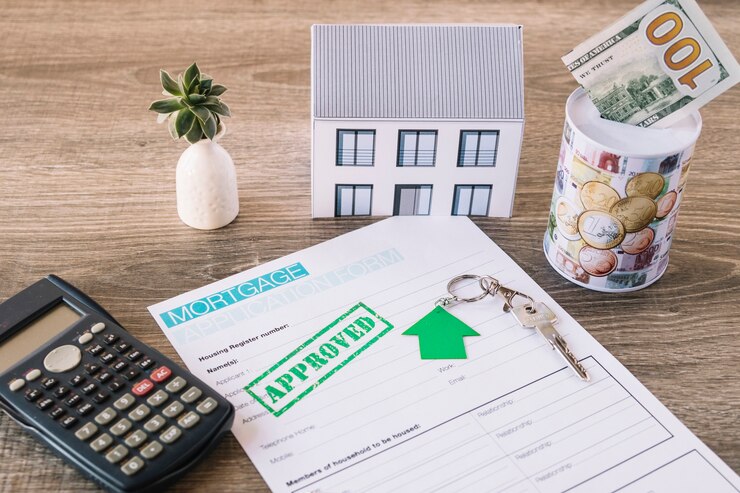What Is a HELOC?
A Home Equity Line of Credit (HELOC) works like a credit card, giving you a flexible line of credit tied to your home’s value. You can withdraw a set amount and pay it back over time with interest. Your credit limit is determined by subtracting your mortgage balance from your home’s appraised value. Lenders then offer a percentage of this equity as a credit line.
Checks or a San Diego County Credit Union Visa® platinum credit card make it easy to get to your home equity line account.
Apart from HELOCs, there are other loan options for homeowners
Home Equity Loan
Unlike HELOCs with variable interest rates, home equity loans have fixed rates.
Homeowners receive a one-time, lump-sum payment based on their home’s equity.
Repayment occurs over time through monthly installments with interest.
Cash-Out Refinance
In a cash-out refinance, homeowners take out a new, larger mortgage to pay off the existing, smaller one.
The excess funds become available for the homeowner to use.
Personal Loan
Personal loans don’t use your home as collateral, resulting in higher interest rates than HELOCs.
These loans provide a one-time payment and have shorter repayment periods.
Each option has benefits and considerations, so it’s important to weigh them carefully based on your financial goals and the nature of your home improvement projects.
How Does a HELOC Work?

To secure a Home Equity Line of Credit (HELOC), you must apply to a lender, usually a bank or credit union. The lender considers factors such as your credit score, income, outstanding mortgage balance, and the appraised value of your property to determine the loan amount. Typically, lenders allow borrowers to access between 60% and 85% of their home’s value minus the outstanding mortgage.
HELOCs are structured with two distinct phases: the draw and repayment periods.
Draw Period
Once your HELOC application is approved, you can withdraw funds over a set period called the draw period, which typically spans around ten years. During this phase, you can access your funds through checks, credit cards, or electronic transfers.
During the draw time, you don’t have to pay back the principal amount. Interest is charged solely on the funds you withdraw. Payments made during the draw period are typically interest-only, although some lenders may also allow you to pay down the principal balance.
Repayment Period
Following the draw period, the repayment period commences. During this stage, access to additional funds is halted, and the repayment of the principal borrowed and accrued interest begins. The repayment period generally lasts about 20 years, featuring a fixed schedule. The specific terms of your HELOC agreement and the lender’s policies determine the repayment schedule.
Qualifying for a HELOC

To qualify for a HELOC, you must have open equity in your home. This means the amount you owe on your home must be less than its worth. Remove the amount you still owe to borrow up to 85% of your home’s value. Like when you first got your mortgage, a lender will also look at your credit score and past, as well as your work history, monthly income, and monthly debts.
Variable Interest Rate
The rate on your home equity line of credit can change monthly if the rate is changeable. An index and a margin are used to figure out the changeable rate.
An index is a piece of financial information banks use to decide how much to charge for a wide range of consumer loans. For example, Bank of America and most other banks use the U.S. Prime Rate from The Wall Street Journal as the base rate for HELOCs. The index can go up or down, which means the HELOC interest rate can also change.
A margin is the other part of a flexible interest rate. It is added to the index. The profit stays the same for as long as the line of credit lasts.
As you take money out of your HELOC, you’ll be sent regular bills with minimum payments, including the principal and the interest. It’s possible for your prices to change if you make extra principal payments or if your amount or interest rate changes. Cutting down on your general debt faster will save you money on interest by letting you make additional principal payments when you can.
Fixed interest rate option
Some lenders, including Bank of America, let you convert some of your HELOC’s variable rate to a fixed rate. Fixed-rate balance payments are predictable and consistent, protecting you from escalating interest rates. See Bank of America’s Fixed-Rate Loan Option.
Exploring the Advantages of a HELOC

Whether you’re planning home renovations, managing education or medical expenses, or consolidating debt, a Home Equity Line of Credit (HELOC) offers a range of benefits:
Flexibility
HELOCs allow you to borrow only what you need up to your approved credit limit. This on-demand access to funds will enable you to manage expenses efficiently, avoiding unnecessary debt.
Lower Interest Rates
HELOCs often boast lower interest rates than credit cards or personal loans. This makes them an appealing option for borrowers seeking cost-effective financing for significant expenses.
Unlike some loan types, HELOCs charge interest solely on the funds you use, not the entire credit line—this targeted interest application results in additional cost savings.
Potential Tax Benefits
One notable advantage is the potential tax benefits. In many cases, the interest paid on a HELOC is tax-deductible, similar to mortgage interest. This can lead to reduced taxable income and lower taxes.
Considering Potential Drawbacks of a HELOC

While a Home Equity Line of Credit (HELOC) offers various benefits, it’s crucial to be aware of potential drawbacks, as with any borrowing method
Fees and Costs
Acquiring a HELOC may involve several costs, such as application fees, annual fees, and, in some cases, closing costs. Homeowners should meticulously review the terms and conditions of their HELOC to comprehend its overall cost.
Careful examination of associated fees is essential to decide whether the benefits outweigh the potential costs.
Variable Interest Rates
While HELOCs often come with variable interest rates, providing potential benefits, they can also introduce uncertainty. Monthly payments may become unpredictable, particularly if interest rates rise. This unpredictability could strain your monthly budget.
Borrowers should carefully evaluate their financial stability and capacity to handle potential fluctuations in interest rates before opting for a HELOC.
Financial Risks
HELOCs are secured by your home’s equity, meaning your property is collateral for the loan. Failure to meet financial commitments could jeopardize your homeownership, potentially leading to foreclosure.
Risk Mitigation
Borrowers should be mindful of their financial situation and have a robust plan to meet their HELOC obligations to mitigate the risk of using home equity as collateral.
Critical Considerations Before Obtaining a HELOC
Before diving into a Home Equity Line of Credit (HELOC), being a well-informed candidate is crucial in assessing your financial standing and future goals. Here are essential considerations:
- Evaluate Your Options:
Align with Financial Strategy: Clearly define why you need a HELOC and assess if it aligns with your overall financial strategy. Consider your current income, expenses, and long-term financial objectives.
Purpose-Driven Decision: Ensure that opting for a HELOC serves a specific purpose that fits into your broader financial plan.
- Review Your Financial Situation:
Equity and Credit Score: Understand that lenders often require at least 15% equity from HELOC candidates. Additionally, a credit score of 680 or higher is typically sought after.
Calculate Monthly Payments: Once you receive a loan offer, calculate potential monthly payments, considering possible fluctuations in interest rates. Assess your ability to meet these payments comfortably.
- Shop Around:
Research Multiple Lenders: Avoid settling for the first offer; research multiple lenders.
Compare Offerings: Pay close attention to interest rates, fees (application fees, annual fees, or prepayment penalties), and repayment terms. Transparency in a lender’s terms is vital.
Consider the Full Picture: While lower interest rates may be appealing, take into account the entire lifespan of the HELOC, including associated fees.
- Seek Professional Guidance:
Financial Advisor Assistance: Consider engaging a financial advisor to guide you if needed. Their expertise can help you navigate complex financial details and make informed decisions.
Steps to Apply for a HELOC
You must navigate the application process after deciding to pursue a Home Equity Line of Credit (HELOC). Here are the typical steps involved:
- Gather Documents:
Collect proof of income, such as pay stubs or tax returns.
Document existing debts, including credit card balances and loans.
Gather property-related documents like the property title, recent mortgage statements, and property appraisal if available.
- Submit an Application:
Complete the lender’s application form, either online or in person.
Provide accurate personal and financial details, along with specifics about your home.
Honesty in information is crucial to prevent delays or issues during the approval process.
- Underwriting and Home Appraisal:
The lender reviews your application and comprehensively assesses your financial standing, credit history, and property value.
An appraiser performs a home appraisal to determine your property’s current market value, influencing the maximum amount you can borrow against its equity.
- Get Approved:
Following the lender’s review, you’ll receive an offer detailing your approved credit limit, interest rate, repayment terms, and associated fees.
This step is crucial as it sets the parameters for your borrowing.
- Accept the Loan:
Carefully review the offer, understanding all terms and conditions.
Clarify the interest rate structure (variable or fixed), repayment terms, withdrawal options, and any additional fees.
If you agree with the terms, sign and return the offer to the lender.
- Access the Money:
Once the agreement is signed and processed, you can access funds from your HELOC account.
The funds are available for withdrawal based on the approved credit limit.
By following these steps, you can successfully apply for a HELOC. It’s crucial to be thorough in providing accurate information, understanding the terms of the offer, and ensuring that the HELOC aligns with your financial goals before accessing the available funds.
How To Use a HELOC
Budget to maximize your HELOC and avoid problems. First, decide what expenses your HELOC will cover. This will prevent you from using your HELOC for non-essential purchases and ensure you only borrow what you need. HELOCs can finance home repairs that increase property value, cover unforeseen medical bills, or consolidate high-interest debt.
Remember to plan how to refund your money. It would be best to analyze your existing and projected financial condition, including income, expenses, credit score, and debt-to-income ratio. Consider worst-case scenarios like interest rate volatility. These exercises will help you calculate how much you can borrow and responsibly repay.
Final Thoughts
A HELOC’s flexibility, tax benefits, and low-interest rate make it a popular choice for homeowners seeking cost-effective expense management. A HELOC can finance a home renovation project, pay tuition, consolidate high-interest debt, or handle an emergency.
However, evaluate your finances before choosing a HELOC. Create an initial budget and payback plan you can follow. Consider overspending, adjustable interest rates, and foreclosure and how to mitigate them. Despite its benefits, a HELOC is only for some situations. By exploring all your options, make a sensible, informed borrowing decision that fits your budget.



